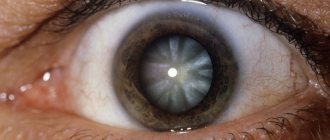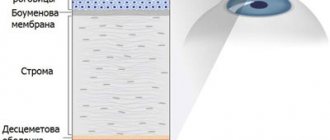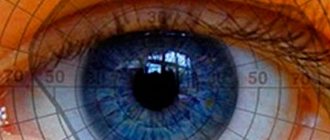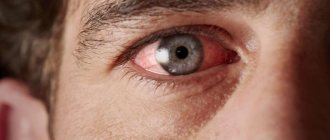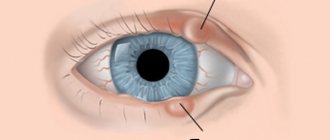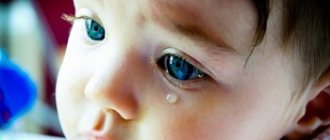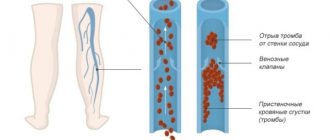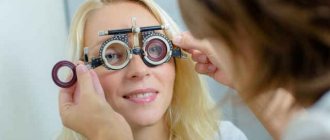Myopia - what is it?
Myopia is a visual impairment in which a person sees well up close, but blurry at a distance. Therefore, the disease has a second, most common name - myopia. It is characterized by refractive error in one eye or both.
Today it is considered a disease of civilization. Which is not at all surprising. The rapid growth of computerization of production and technology increases the number of cases exponentially. It is noteworthy that it occurs most often between the ages of 7 and 18 years. At older ages, it either remains in place or progresses.
Doctors explain the physics of the disease as follows: the image of distant objects in myopic people is focused not on the retina, as in healthy people, but in front of it, so at a distance a person sees objects unclearly and blurry.
Progressive myopia
This is a dangerous condition in which vision decreases very quickly: up to several diopters within a year. The pathology is accompanied by deformation of the shape of the eyeball, blood vessels, and vitreous body. As a result, retinal detachment and complete loss of vision can occur. The causes of the pathology are regular overwork of the visual apparatus against the background of reduced immunity and insufficient nutrition, poor ecology, and a sedentary lifestyle.
Progressive myopia can be true or false. False (pseudomyopia) appears under severe stress or heavy visual load. Schoolchildren usually suffer from this. The child ceases to clearly distinguish objects, vision becomes blurred. Also, false myopia is promoted by a spasm of accommodation, when the ciliary muscle does not respond to the visual process and remains motionless.
When looking into the distance, the lens does not change its shape, and a person cannot clearly visualize objects. This problem hinders students' learning as they cannot see the writing on the blackboard.
True progressive myopia is much more difficult to treat, since the pathology has affected the internal structures of the visual apparatus. The lens gradually changes shape and becomes more elongated. This interferes with the focusing of the flow of light rays, and the person ceases to distinguish objects far from him. In childhood, progressive myopia may stop after the formation of the fundus of the eye is completed, so ophthalmological operations are not performed until the age of 18.
How to recognize
Signs of progressive myopia:
- poor visibility of distant objects;
- the appearance of spots before the eyes;
- To focus on a distant object, you need to squint your eyes.
This pathology can be hereditary due to congenital weakness of the sclera. But more often, progressive myopia develops with excessive visual stress, especially with constant use of gadgets (cell phones, computer games, etc.). The optical apparatus adapts to new conditions and rebuilds its system (the axis of the eye lengthens). Therefore, it is highly undesirable to use a laptop/iPhone while lying down.
The situation is aggravated by insufficient nutrition (lack of vitamins, deficiency of microelements), lack of normal physical activity on the muscles, poor ecology, constant stress, and reduced immunity. Infectious diseases also contribute - acute respiratory viral infections, influenza, sore throats. Also, myopia begins to progress against the background of hormonal changes in the body: menopause, diabetes, pregnancy, etc.
Myopia in children
Cases of congenital refractive error of the eye are quite rare and are caused by abnormalities in the development of the organ of vision. This is due to hereditary predisposition if both parents have the same diagnosis.
In children under one year of age, pathology rarely occurs. More often, mild deviations from the norm in both eyes occur in school-age children due to increased eye strain and failure to comply with basic occupational hygiene rules. Long-term entertainment at the computer and watching television programs have a negative effect on the eyes.
A small child cannot complain about his eyes, since the anomaly does not cause pain. Therefore, parents should be attentive to the behavior of their baby, pay attention to the manifestation of symptoms: low head tilt when reading and drawing; squinting; inability to distinguish distant objects.
PREVENTION
The most effective in preventing the development of myopia are:
- correct organization of the visual load regime;
- sufficient lighting when reading, working at the computer;
- periodically performing eye exercises;
- balanced diet;
- taking vitamins;
- undergoing preventive examinations on an annual basis;
- contact a specialist if ophthalmological symptoms appear.
- use of probiotic drugs.
Myopia of both eyes
Some people with myopia experience worsening twilight vision. In this case, myopia occurs in both eyes. Such patients orient themselves much worse after dark. A person has to constantly strain his eyes, which leads to muscular asthenopia - visual fatigue.
As a result, the symptoms of the anomaly are supplemented by pain in the eyes, aching in the eye sockets, and severe headaches. A progressive disease requires frequent replacement of glasses and lenses, since the previous ones no longer correspond to the degree of the disease and no longer correct vision.
Signs of myopia in both eyes include slight bulging eyes due to elongation of the anterior-posterior axis of the eye, accompanied by a widening of the visual fissure. As a result of the destruction of the vitreous body, the vessels become visible, acquiring a bluish tint. There is also a feeling of “strings”, “balls of wool”, “flying flies”.
Prevention of myopia
In order to prevent this disease, you must constantly adhere to several rules. First of all, it is important that all visual stress occurs only in high-quality lighting: either overhead light or a 60-100 W table lamp. Fluorescent lamps have a negative effect on vision.
It is important to constantly alternate intense visual loads with rest and active motor exercises. It is worth considering that if myopia is greater than 3 diopters, lifting weights and jumping is prohibited.
If your visual activity is intense, you should take breaks every 30-40 minutes and fill the pause with eye exercises.
It is necessary to be very careful about protecting your eyes from various injuries and foreign objects getting into your eyes during some work. As a result of injury, damage to the oculomotor nerve, displacement of the lens, and hemorrhage may occur.
Provided that myopia has already begun to develop, vision correction with glasses will significantly slow down the progression of the disease.
You should regularly take vitamin complexes and provide a nutritious and varied diet.
Reasons for the development of myopia
Among the reasons leading to the development of pathology, ophthalmologists identify the following:
- Heredity. If one or both parents have this diagnosis, then the likelihood of the disease manifesting itself in children is extremely high.
- Unbalanced diet. A lack of vitamins such as copper, manganese, zinc, magnesium leads to deviations from the norm.
- Excessive stress and overwork cause the mucous membranes of the eye to dry out and the muscles that support it to degrade.
- Lack of physical activity, sedentary lifestyle, prolonged sitting.
- Lack of correct writing and reading skills: long work without breaks, failure to maintain the distance between objects, reading in transport, lying down, incorrect sitting position, illiterate lighting arrangement. Therefore, school and professional myopia quickly develops and progresses.
- This pathology is accompanied by other diseases of the visual organs, such as amblyopia, astigmatism, strabismus, keratoglobus, keratoconus.
- Hormonal imbalances.
- Increased or decreased intracranial pressure.
- Diseases of the cerebral vessels lead to impaired blood supply to the eyes and deterioration of vision.
- False myopia, caused by a spasm of accommodation and muscle overload, gradually leads to the development of true myopia.
- Past fungal, bacterial, viral infections.
- Suffered traumatic brain injuries.
- Birth injuries.
- Poisoning of the body.
- Lack of competent diagnosis and correction, non-compliance with the rules of wearing lenses and glasses.
Despite the abundance of reasons, heredity remains the main factor. Therefore, children with a similar risk should be monitored by an ophthalmologist. All other factors are provoking causes that influence the formation of vision pathology.
COMPLICATIONS
Considering that myopia is a disease that is prone to progression, its course may become more complicated if it is not corrected in a timely manner.
Complications of myopia:
- formation of scleral protrusions;
- changes in the retina associated with insufficient supply of nutrients;
- hemorrhages in the vitreous body;
- retinal detachment of the eye.
Main symptoms of myopia
Most people do not immediately notice worsening vision. Therefore, they visit the ophthalmologist untimely and detect the disease at a late stage. It is often discovered during preventive medical examinations. In most cases, visual acuity decreases gradually; a person does not pay attention to it for a long time.
The main symptom of the disease is difficulty in viewing distant objects. Over time, the following symptoms appear: constant squinting; headache; pain in the back of the head, temples, eyes; the sclera acquires a bluish tint; there is a desire to rub your eyes to see objects better; the eyes become tense and tired quickly; the appearance of light flashes, flies; decreased twilight vision.
The appearance of any symptom requires immediate contact with a qualified specialist who will conduct a competent diagnosis and prescribe treatment.
General information
Myopia is a very common eye disease today. The more well-known name for this disease is myopia . This disease has been known since ancient times: it was first mentioned by the ancient Greek Aristotle. Thus, in his writings, he noted that some people have a need to bring an object very close to their eyes in order to see it well, and at the same time they have to squint hard.
Degrees and types of disease
Ophthalmologists diagnose myopia in three degrees:
- 1 weak degree – visual impairment up to 3 diopters;
- 2 medium degree – from 3 to 6 diopters;
- 3 high degree - over 6 diopters.
According to the clinical course, myopia can be of two types: progressive and non-progressive.
With non-progressive vision, vision does not decrease over time, does not require treatment, and can be corrected with lenses or glasses.
With progression, the quality of vision constantly deteriorates; it is necessary to increase the lenses to stronger ones once a year. It can cause the development of serious complications, such as retinal dystrophy and detachment, cataracts, glaucoma, which subsequently require surgical intervention.
If you notice symptoms of the disease in your child or yourself, contact your ophthalmologist immediately for advice.
Diagnosis by symptoms
Only a qualified ophthalmologist can make a correct diagnosis of a patient. This is not difficult and is based on a vision test using tables. Additionally, special studies may be prescribed:
- Visometry - determination of visual acuity with correction;
- Perimetry – determination of visual fields;
- Tonometry - determination of intraocular pressure;
- Ophthalmoscopy – examination of the fundus of the eye;
- Skiascopy is the study of shadow movement in the pupil area;
- Ophthalmometry - determination of the optical power of the cornea;
- Refractometry - after dilating the pupil, you can determine the true refraction of the eye;
- Ultrasound examination of the eye and determination of the anterior-posterior segment;
- Tonography is a study of the production and outflow of intraocular fluid.
You can only trust your health to a specialist - an ophthalmologist.
DIAGNOSTICS
When examining a patient with signs of myopia, it is necessary to obtain a detailed understanding of the clinical features and course of the disease, so a certain algorithm should be followed.
Anamnesis
When conducting an anamnestic survey, it is important to find out the following points:
- the number of completed years of the patient at the time of the onset of the disease;
- initial symptoms;
- subjective assessment of the dynamics of visual impairment;
- conditions and mode of visual work;
- nature of professional activity;
- previous infectious and somatic diseases;
- changes in general condition;
- experience using glasses;
- the presence of myopia in close family members.
Patient examination
During the examination, you can see the patient's characteristic squinting to improve image quality.
Determination of visual acuity
The manipulation is performed both separately for each eye and binocularly. For this purpose, ophthalmic lenses with positive (“plus”) and negative (“minus”) diopter numbers are used.
Visual acuity is determined first without correction, and then with the glasses used by the patient. If the patient has not previously corrected his vision, the ophthalmologist selects the minimum spherical negative lens that will achieve the best result in the test.
The use of lenses allows for a differential diagnosis of myopia with organic lesions, diseases of the lens and optic nerve.
Ophthalmoscopy
When examining the fundus and eye media in patients with myopia, the following is determined:
- focal vitreous opacities;
- hemorrhages, diffuse opacities, pigmentation of the retina;
- condition of the fundus vessels;
- decreased blood supply to eye structures;
- areas of retinal degeneration and detachment.
Study of the condition of the ciliary muscle
Special techniques for studying the tone of the ciliary muscle make it possible to predict ways of optimal vision correction. Violation of its contractility requires the inclusion in treatment regimens of medications aimed at relaxing muscle fiber cells.
Other diagnostic methods
To clarify the diagnosis, an ultrasound examination of the anteroposterior segment of the eyeball is performed. This technique allows us to exclude congenital pathologies of the visual organs.
Diagnosis of myopia in children
Speaking about the symptoms of myopia, it is important to note the fact that the pathology is characterized by a long asymptomatic course. Therefore, only an ophthalmologist can identify it.
Most often this diagnosis is given to school-age children. After all, it is at this time that children experience intense stress on their visual apparatus during their studies.
If you carefully observe the children at this time, you can easily notice that some are not so good at distinguishing distant objects, have trouble seeing the lines on the board, squint when looking into the distance, and try to get closer to the object in question.
How is myopia treated?
Myopia should be treated as soon as the diagnosis is made. Possible methods of vision correction that give a chance to return normal acuity are as follows:
- Drug therapy. Courses are provided to patients with any degree. Pharmaceutical drugs are prescribed: B vitamins; calcium; stimulating blood circulation in the brain, tissue therapy.
- Correction with lenses and glasses. The strength of the lenses is strictly individually selected. Choosing contact lenses or glasses depends on a person's preference.
- Hardware therapy. Correction is carried out using a laser, accomodo trainer, and color pulse treatment.
- Surgical techniques. Used for rapid progression of pathology. The main goal is to stop the development of the pathological process.
- Laser correction. A modern, effective procedure that restores vision by changing the shape of the cornea.
Correcting myopia with glasses or contact lenses
Whether contact or spectacle correction is indicated depends on the doctor’s recommendations and the patient’s wishes. In any case, the power of the lenses is selected so that the tolerable diopter is weaker than the refraction. Many people prefer glasses. But they are not always comfortable - the windows get dirty and fog up, and glasses fall off.
Unlike glasses, contact lenses have more advantages - they are invisible, allow you to lead an active lifestyle, have clear lateral vision, and do not become covered in perspiration. But there are also contraindications - allergies, intolerance, inflammatory diseases.
The purpose of this correction is to correct the focus of the image. Only incorrectly selected glasses or lenses can impair vision.
MYOPIA – A MODERN DISEASE
WHAT IS MYOPIA?
When a person sees poorly in the distance, but more or less clearly only near, people immediately say that he has “myopia,” since he sees literally at arm’s length. However, in medicine the term “myopia” does not exist; such a refractive error of the eye is called “myopia”.
Normally, with good vision, rays from the objects in question are refracted by the optical system of the eye (cornea and lens) and collected at a point (focus) directly on the retina in a certain place. At the same time, a person clearly sees distant objects.
With myopia, the image from the objects in question is formed in front of the retina. This is due to the fact that the optical system of the eye works too hard (refracts rays strongly) and/or the length of the eye is longer than normal. As a result, a person sees distant objects blurry.
Myopia can be acquired or congenital. Acquired myopia appears in a person after birth and, as a rule, its development is associated with excessive visual stress. A striking example of acquired myopia is the so-called “school” myopia. It is at school age that intense stress on vision begins and increases sharply, when you have to spend a lot of time reading, writing, and, more recently, on a monitor. As a result, constant and excessive tension of the eye muscles when working at close range leads to myopia. Of course, the following also influence vision deterioration:
- bad light,
- incorrect posture/posture,
- lack of preventive measures.
The same reasons explain the connection between the ever-increasing number of myopic people in the world and the equally rapidly progressing number of gadgets. Although the point is not entirely in the “malicious devices” themselves, but in the principle and frequency of working with them, because the eye is absolutely just as tense at close range for a long time while we are looking at a smartphone, just like schoolchildren during constant reading and other activities.
Congenital myopia develops before the baby is born and can be diagnosed immediately after birth. Its reasons are given as:
- premature birth or birth trauma;
- various diseases;
- bad habits of the mother during pregnancy.
Most often, congenital myopia progresses quickly and reaches fairly high degrees.
Experts have proven that myopia is a disease with a hereditary predisposition. This does not mean that myopia as a disease is absolutely inherited. Children whose parents suffer from myopia inherit the specific composition of the tissues of the membranes of the eye, which, when exposed to unfavorable factors, more often than in other cases leads to the development of myopia.
Unfavorable factors contributing to the development of myopia include:
- sedentary lifestyle;
- unhealthy diet (+ lack of vitamins);
- intense visual stress at close range;
- bad habits.
HOW TO TREAT MYOPIA?
The opinion of traditional medicine is this: myopia cannot be completely cured, but it can and should (!) be corrected, which in medical language means “correct, correct.” Myopia correction is based on correcting the action of the optical system, and for this today there are 3 main methods:
- wearing glasses;
- use for correction of contact lenses (soft or hard);
- laser correction.
Glasses are the most ancient and well-known method of correcting myopia. In addition, it is as affordable as possible in terms of purchase and wearing. And today glasses are also a very fashionable accessory.
Contact lenses are already beginning to overtake glasses in popularity. This is not surprising, because they have excellent advantages:
- convenience (do not fall, do not break, do not fog up, etc.)
- aesthetics (do not cover the face, do not change appearance).
With laser correction, a violation of the refractive power of the cornea is corrected with a laser (the shape of the cornea is changed, as a result of which its refractive power changes). Unlike glasses and contact lenses, with laser correction it is much more difficult to predict the result. Since each body may react differently to surgery, there is always some risk. Sometimes it is not possible to completely correct myopia with laser, and after surgery you still have to use glasses or contacts. The irreversibility of the result of this operation is also one of the factors that must be kept in mind when choosing this method. Although, of course, modern technologies make it possible to achieve a positive result.
I would like to note that only a medical specialist should select a method of vision correction for myopia, as well as give recommendations on which one to prefer in your particular case.
WHAT HAPPENS IF YOU DON'T WEAR GLASSES?
Some time ago, it was widely believed that wearing glasses relaxes the muscles too much (“does not force the eyes to work”), as a result of which myopia can progress. For this reason, some specialists who adhere to this theory did not prescribe glasses and contact lenses for low degrees of myopia (up to -1.0-1.5 diopters). Modern doctors categorically reject this theory.
To explain as clearly as possible why you still need to use glasses or contacts, let’s make an analogy. The human eye is a complex optical system and all processes in it are interconnected. The lens (part of the refractive optical system of the eye) works on the principle of the “zoom” function on a camera. It “slides forward”, i.e. changes its curvature so that we can see objects up close. In myopes (people suffering from myopia) who do not use vision correction, i.e. those who do not wear glasses or contacts, the lens, and with it the muscles, does not work like a zoom, because a person already sees well up close. Over time, this leads to weakening of the intraocular muscles. When a person puts on glasses, he begins to see well into the distance, which means that in order to see something close up, he needs a zoom. Wearing glasses forces the intraocular muscles and lens to work properly and naturally.
By the way, it is for this reason that people who have not corrected their poor vision for a long time may experience quite strong discomfort when they start using glasses for the first time - after all, the muscles have already weakened greatly, and now they are “forced” to work again. At this time, it is highly discouraged to stop wearing glasses again. If the unpleasant sensations from new glasses cause severe inconvenience that does not go away within a few days, you should consult a doctor again. In such cases, doctors, as a rule, prescribe glasses with weaker optical power for the first time, and gradually increase it in the future, thereby distributing the load on weakened muscles.
In the Ochkarik optics salons, experienced medical specialists will conduct an eye exam, select the appropriate vision correction method, and give personal recommendations. To avoid waiting, we recommend that you always make an appointment in advance on our website: .
When writing this article, materials from the following sites were used: who.int, bbc.com, ozrenii.com.
* As of 2010: https://www.who.int/features/factfiles/blindness/blindness_facts/ru/index1.html
Physical education for myopia
Limiting sports activities for people suffering from myopia is considered wrong. Today, the important role of physical activity in preventing pathology has been proven. Physical activity contributes to a general strengthening effect on the body, activation of all functions, increased efficiency of the ciliary muscle, and strengthening of the scleral membrane.
Aerobic exercise - running, cycling, swimming, skiing - has a good effect on the accommodative function of the eye and the circulatory system. Training should be of moderate intensity, heart rate should not exceed 140 beats per minute. More intense loads negatively affect the performance of the ciliary muscle.
For mild myopia, games with muscle stretching are recommended - basketball, tennis, volleyball, which improve accommodation by changing the focus of the gaze from distant objects to near ones.
In case of moderate disease, the following types of physical activity are prohibited: moderate physical gymnastics, jumping from a height of more than 1.5 meters.
For high myopia, only exercises from the group of special physical therapy are recommended.
Gymnastics for the eyes
Mild myopia in both eyes can be easily eliminated by performing special therapeutic eye exercises. Perform only in a sitting position.
Close your eyes tightly for five seconds, then open them for five seconds. Repeat 8 times.
Blink quickly with both eyes for two minutes.
Close your eyelids. Massage them gently for a minute using circular movements of your fingers.
Press on the upper eyelids with three fingers; after two seconds, stop the pressure and remove your fingers from the eyelids. Repeat 4 times.
Fix the skin of the brow ridges with your index fingers, then slowly close your eyes. Hold the skin of the brow ridges firmly. Good muscle workout. Repeat 10 times.
Myopia and traditional medicine
Some traditional medicine recipes can not only reduce the progression of the disease, but also use them as a treatment method at home. Plants such as sea buckthorn, nettle, black currant, rose hips, red rowan and others help with this.
Mix black currant berries, brown rose hips, carrot roots, nettle leaves in a ratio of 3:3:3:1. Take 2 tablespoons of the mixture, brew 400 ml of boiling water, simmer over low heat for 15 minutes. Infuse, strain. Take 100-200 ml of warm infusion before meals 4 times a day. Unadvanced myopia recedes.
Mix the leaves of stinging nettle and the leaves and fruits of red rowan in a 3:1 ratio. Pour 2 cups of hot water into 1 tablespoon of the mixture and boil for 15 minutes. Infuse, strain. Drink half a glass of the warm infusion before meals.
Brew 1 teaspoon of sea buckthorn in 200 ml of boiling water. Leave for two hours, strain. Take a glass before meals.
Pour 1 tsp of dried Chinese lemongrass leaves into a glass of hot water and boil for 20 minutes over low heat. Infuse, strain. Take 3 tbsp before meals 3 times a day.
